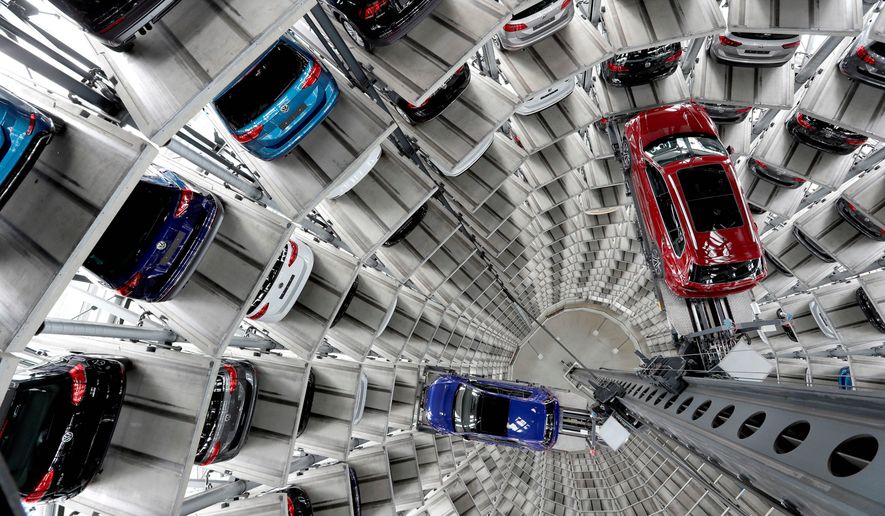President Trump offered European nations and other countries a zero-tariff deal as a way out of an escalating trade war, but so far he has no takers despite a zero-tariff agreement signed last week between the European Union and Japan.
With a battle over auto tariffs breaking out between the U.S. and Europe, Mr. Trump’s proposal to eliminate all import duties and trade barriers will be on the table again when EU Commission President Jean-Claude Juncker sits down Wednesday at the White House.
“Not going to get ahead of the president’s meeting, but this is something the president has said he would like to see,” said White House press secretary Sarah Huckabee Sanders.
The EU so far would rather fight than deal.
In retaliation against the Trump administration’s steel and aluminum tariffs, the EU imposed tariffs on $3.25 billion of American-made staples including bourbon and motorcycles.
EU Trade Commissioner Cecilia Malmstrom, who will accompany Mr. Juncker to Washington this week, said they will bring a new list of U.S. goods targeted for sanctions if Mr. Trump doesn’t back down.
“The aim of President Juncker’s visit is to try to establish good relations, try to see how we can de-escalate the situation,” Ms. Malmstrom told reporters in Brussels. “We don’t go there to negotiate anything.”
Mr. Trump gets most of the blame — both in the U.S. and abroad — for igniting the trade war in March when he slapped tariffs on steel and aluminum to bolster domestic production of those metals, which that have vital military uses.
The trade fight quickly heated up with the Trump administration hitting $34 billion worth of Chinese goods with tariffs and Beijing responding in kind. The threat of tit-for-tat tariffs with the EU is the next flashpoint.
After winning the White House with a get-tough trade agenda, Mr. Trump insists that he is doing what he promised: standing up for American workers.
The president argues that American workers and business suffered for decades because of lopsided trade deals in which the U.S. levies low tariffs while major trading partners such as the EU hammer U.S. goods with steep import duties and other trade barriers.
The EU imposes a 10 percent tariff on passenger cars, compared with the 2.5 percent U.S. duty on European autos.
A study by the CESifo Institute in Germany found unweighted average EU tariffs of 5.2 percent, compared with the U.S. rate of 3.5 percent.
“The EU is by no means the paradise for free traders that it likes to think,” Gabriel Felbermayr, director of the think tank’s Center for International Economics, told the German business newspaper Handelsblatt.
Sometimes the tariffs are unbalanced in the opposite direction. The U.S. has a higher, 25 percent duty on imported pickup trucks and sport utility vehicles, while the EU charges the same 10 percent tariff on most vehicles. For commercial trucks, the U.S. levies a 25 parent tariff and the EU 22 percent.
At last month’s meeting of the Group of Seven leading industrial nations, Mr. Trump floated the idea of zero tariffs to leaders of Britain, Canada, France, Germany, Italy and Japan.
“Ultimately that’s what you want. You want tariff-free, no barriers, and you want no subsides because you have some countries subsidizing industries, and that’s not fair,” he told them. “So you go tariff-free, you go barrier-free, you go subsidy-free. That’s the way you learned at the Wharton School of Finance.”
Last week, the EU and Japan signed a sweeping trade deal that will eliminate nearly all tariffs when they trade. They said it sent a clear message against protectionism — an apparent dig at Mr. Trump.
Neither the EU nor Japan has publicly entertained Mr. Trump’s zero-tariff proposal.
The Trans-Pacific Partnership deal eventually would have reduced tariffs to zero for the 12 countries involved, including the U.S. and Japan. Pulling out of the deal was one of Mr. Trump’s first acts as president. He said the multination agreement would have increased U.S. trade deficits and shipped American jobs overseas.
The Transatlantic Trade and Investment Partnership deal between the U.S. and the EU would have cut most tariffs to zero. But negotiations were suspended indefinitely in 2016 amid opposition on both sides of the Atlantic, but with the fiercest resistance from Europeans.
Moves to rekindle the talks after Mr. Trump took office in 2017 have been overshadowed by the tariff wars.
Edward Alden, a senior fellow specializing in U.S. economic competitiveness and trade at the Council on Foreign Relations, said it was easier for the EU and Japan to strike a zero-tariff deal than to do the same with the U.S.
Beyond tariffs, the Europeans don’t see eye to eye with the U.S. on environmental and agriculture issues that frustrate trade agreements.
“We bathe our chickens in a light chlorine solution, and we like hormones in our beef, and we use genetically modified crops in ways that they don’t do,” said Mr. Alden. “Japan doesn’t raise the same set of issues because Japan is not trying to force Europeans to recognize Japanese regulatory standards. They are happy to live with the European regulatory standard.”
He agreed with Mr. Trump that most trade deals — including the North Atlantic Free Trade Agreement and China’s membership in the World Trade Organization — backfired on the U.S. and caused jobs to be shipped abroad and higher trade deficits. But he also questioned Mr. Trump’s sincerity in proposing zero-tariff deals.
“I think what the president really wants is unilateral concessions from the Europeans. He wants to get rid of their 10 percent car tariff, for example, without the U.S. having to respond in kind,” Mr. Alden said. “But the truth is I don’t know. Nobody really knows.”
• S.A. Miller can be reached at smiller@washingtontimes.com.




Please read our comment policy before commenting.